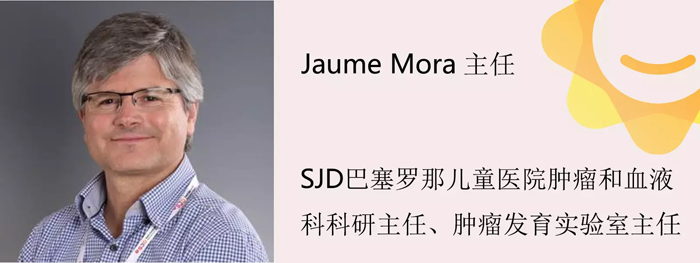神经母细胞瘤具有遗传性吗?生二胎是也会受影响?
文章来源:向日葵儿童 作者:向日葵儿童 责任编辑:admin 时间:2019-05-28
向日葵志愿者 | 子荷 培煌
排版 | 文艳
校对 | 何飞 陈臻宇
『向日葵问答』是向日葵儿童的旗舰科普项目。
每周我们都会邀请顶尖专家参与,大家可以在征集问题的文章后留言,专家老师会选取相关的问题进行回答。
| Tips:因为无法对患者面对面进行诊断,不了解患者的具体病情,医生的意见仅作参考,具体治疗方式请咨询主治医生。 |
第58期,我们有幸邀请到SJD巴塞罗那儿童医院肿瘤和血液科Jaume Mora医生,为我们解答关于“儿童神经母细胞瘤、实体瘤诊疗”方面的问题。

Jaume Mora Graupera,SJD巴塞罗那儿童医院肿瘤和血液科科研主任、肿瘤发育实验室主任、巴塞罗那生物医学研究所肿瘤项目成员。
本期问答如下,大家可以寻找自己关心的问题。
Q:男孩,4岁,确诊神经母细胞瘤时伴有淋巴结、骨髓、骨转移。手术完整切除。目前进行术后化疗,接下来想进行3F8免疫治疗(3F8是一种针对神经母细胞瘤中高度表达的神经节苷脂抗原GD2的抗体,可以有效地附着在神经母细胞瘤细胞上,并被免疫系统识别,从而依靠患者自身的免疫系统来攻击和杀灭肿瘤细胞),不打算干细胞移植,但目前骨头还有残留。请问目前这种有残留的情况下,化疗完成后适合接受免疫治疗吗?还是化疗完全缓解后做效果更好?
Dr. Mora: Bone and bone marrow refractory disease is quite common after induction treatment (chemotherapy and surgery). Unfortunately, the outcome for patients with primary refractory disease has not changed with conventional strategies like high-dose chemotherapy and autologous transplant. Only anti-GD2 immunotherapy has changed the overall survival of patients with primary bone and bone marrow refractory disease. Fortunately, anti-GD2 antibodies work better in the bone/BM environment therefore this is the site where antibodies are most active against neuroblastoma. I would not recommend to delay anti-GD2 immunotherapy for patients with primary refractory disease in the B/BM after standard induction treatment.
A:经过前期诱导性治疗(化疗和手术)后依然有难治的骨和骨髓转移是很常见的。并且,对于这种初诊难治型的患儿,即便采用高剂量化疗和自体移植等传统的治疗方式,其预后依然不是很理想,目前只有抗GD2免疫治疗能改善这类患儿的总体生存率。很幸运的是,因GD2的抗体在骨和骨髓环境中作用效果较好,所以应用GD2抗体治疗神经母细胞瘤骨和骨髓等部位的转移是最有效的。对于初诊具有骨和骨髓转移的患儿,我建议在诱导性治疗结束之后,尽快上免疫治疗。
Q:女孩,4岁,神经母细胞瘤四期,经过前期化疗和完整手术切除,目前处于术后的巩固化疗阶段。请问后期需要干细胞移植吗?后续的一系列标准治疗有哪些?
Dr.Mora: High-dose chemotherapy and autologous transplantation (ABMT) has shown to increase the event-free survival (EFS) for patients with high-risk neuroblastoma, but not the overall survival (OS). What does this mean? It means that patients do relapse later and when they relapse, there was no salvage regimen after relapse, EFS was used to measure the impact of treatments in this disease. However, since we have shown that relapsed patients can effectively salvaged and even a 40% rate can be cured, EFS is no longer a valid measure for this disease.
The potential cure for patients after relapse has changed radically the way this disease is approached. ABMT is no longer seen as the last chance for patients, even if there were not in complete remission. Also, active surveillance should be performed after initial treatment to pick-up relapses as soon as possible since they are amenable to rescue treatments. This radical change has occurred after anti-GD2 immunotherapy showed that OS can be improved. Antibodies anti-GD2 have increased the OS but not the EFS. It means that indeed the patients can relapse after initial treatment but they are not bound to die necessarily. Rescue treatments and second or further complete remissions are possible. Even cures are possible after relapse.
In summary, consolidation of all high-risk NB patients should include radiotherapy and anti-GD2 immunotherapy. In our opinion, immunotherapy the sooner the better.
A:高剂量的化疗和自体骨髓移植对延长高危组神经母细胞瘤患儿的无病生存期有提高,但是对最终的治愈率并没有很大的帮助。自体骨髓移植(ABMT)已不再是患儿甚至病情未完全缓解的患儿最后的选择。
在治疗初期,应该对患儿病情进行严密的监测,以便及早发现复发迹象来施行拯救方案。抗GD2免疫治疗可以提高总体生存期, 也就是说即便患儿经治疗后出现复发,采用拯救性治疗方案以及达到再次或多次的病情完全缓解,甚至于治愈都是有可能的。总体来说,对于高危组的神经母细胞瘤病人,巩固性治疗应该包括放疗和抗GD2的免疫性治疗。在我看来,免疫治疗越早进行越好。
Q:男孩,2岁,神经母细胞瘤,左颈部脸颊下方淋巴结肿大,手术切除。病理诊断为“分化差型神经母细胞瘤”。骨穿检查发现骨髓被侵犯,颈胸腹增强CT、头部MRI、全身PET-CT检查未发现其他病灶。按“四期高危型神经母细胞瘤”化疗,已完成第一疗。请问(1)手术切除进行病理检查的全是左颈部脸颊下方的淋巴组织,进一步检查未发现其他病灶,原发灶在颈部淋巴还是罕见的不明原发灶?(2)需要进行放疗治疗吗?
Dr. Mora: (1) An appropriate extent of disease evaluation at diagnosis should include, always, 123I-MIBG, bone scan, whole body MRI or CT and bone marrow tests. I’m very aware that 123I-MIBG is not available in most parts of the world including China therefore it is very hard to rule out for certain other sites of disease at presentation. 123I-MIBG is the most sensitive and specific imaging test for neuroblastoma.
(2) We do recommend to radiate all the primary tumors and bulky (>5cm) sites at diagnosis.
A:(1)全面的疾病诊断评估指标应该包括123I-MIBG (Meta-iodobenzylguanidine),间位碘代苄胍,去甲肾上腺素的功能类似物,作为放射性药物用于神经母细胞瘤的诊断,骨扫描,全身的MRI或者CT和骨髓检测。123I-MIBG是诊断神经母细胞瘤最敏感、最具有特异性的图像检测,但我知道目前世界上大部分地方包括中国是没有做123I-MIBG检查的,因此暂时无法确定其他部位是否有病灶存在。
(2)对于原发肿瘤或诊断时体积大于5cm的肿块,我们都推荐进行放疗。
Q:女孩,2岁,神经母细胞瘤,19个月时因“共济失调”查出神经母细胞瘤,定为I-II期中危,无扩散与转移。直接手术,术后病理示分化型,N-myc基因无扩增。术后已行6次化疗。请问(1)如果5年不复发,以后会影响怀孕生育吗?(2)神经母细胞瘤具有遗传性吗?若生二胎是否也会得此病?
Dr. Mora: (1) Locoregional neuroblastoma, well differentiated, that cause opsoclonus-myoclonus-ataxia (OMA) syndrome is a well-recognized entity. By definition, neuroblastic tumors that can generate such auto-immune responses are well differentiated and thus not aggressive. Usually we do not use chemotherapy for such cases. Only surgery is necessary. The oncological prognosis is excellent. The problem is the neurological damage that can ensue the OMA syndrome. The neurological prognosis is not so great and sometimes requires an aggressive management by neurologist. You should worry about neurological outcome not the generating capacity in the future.
(2) Neuroblastoma is in the great majority of cases a non-hereditary disease. Familial neuroblastoma has been described in rare families around the world. The incidence in China is unknown to me. Usually it is linked to Phox2B and ALK germline mutations. The family history of the disease and the analysis of those mutations in the tumor can easily rule out the possibility of familial neuroblastoma.
A:(1)局限的、高分化的神经母细胞瘤常常会引起“眼阵挛-肌阵挛共济失调症(OMA)”。从定义上讲,这种产生自身免疫反应的神经母细胞瘤通常是分化程度高,恶性度不高的类型。此类型肿瘤总的预后是很好的,除了引起神经损伤会导致眼阵挛-肌阵挛共济失调。对这类病例,我们一般不进行化疗,单纯手术治疗即可。在神经方面的预后不佳,有时神经科的医生需要施行激进的治疗方案。所以我认为,应该考虑的是神经方面的预后而不是对生育能力的影响。
(2)大部分神经母细胞瘤病例是非遗传性的。世界范围内,家族性神经母细胞瘤十分罕见,但我不了解该病在中国的发病率。一般情况下,家族性神经母细胞瘤常常和生殖系的Phox2B和ALK突变有关。通过疾病的家族史和相应基因突变检测分析,就可以简单地排除“家族性神经母细胞瘤”的可能性。
Q:男孩,2岁,肿瘤位于右侧肾上腺,3个月时确诊为神经母细胞瘤一期,直径3cm左右,直接手术切除。目前每3个月复查,一切指标正常。请问,术后满2年,是不是复发的概率就很小了,基本算治愈?
Dr. Mora: 60% of all neuroblastic tumors have favorable biology, meaning they are cured on their own or with minimal therapy. Usually infants with locoregional tumors harbor favorable biology and thus are highly curable with minimal or no therapy. The history of the quiz case suggests favorable biology therefore it is likely cured. To be more certain and help with the management of these cases biological studies of the tumors should be established as the only way to be certain in the prognosis.
A:大概60%的神经母细胞瘤生物学行为都是比较好的,即它们可以自愈或者只需要轻度治疗即可治愈。一般来说,发生在婴儿时期有局限性伴肿瘤生物学行为良好的肿瘤,治愈的可能性很高。通过轻度治疗或者无需治疗即可痊愈。根据此病例显示,患儿的肿瘤恶性程度并不高,极大可能已经痊愈了。但为了进一步确定是否已经痊愈以及帮助此类案例的治疗,有必要针对此类肿瘤的生物学特性开展研究,这也是作为确定预后的唯一途径。
Q:男孩,2岁,神经母细胞瘤,四期高危型伴骨转移。行化疗4疗程后手术切除左肾上腺原发病灶。术后再行化疗6个疗程并行放疗和MIBG治疗(Meta-iodobenzylguanidine,间位碘代苄胍,新型放疗模式,属于器官靶向治疗)。请问骨转移和肺部转移有什么办法可以控制或治疗?
Dr. Mora: Bone and BM disease is the usual site of high-risk neuroblastoma to colonize. We call it metastasis but nobody is really certain that B/BM disease is in fact a metastatic site from a supposedly primary tumor (adrenal or other). The fact is that stage 4 neuroblastoma does not evolve from locoregional (stages 1-3) neuroblastoma in their evolution. Thus we should not consider stage 4 a bad progression from a previously less aggressive, and non-metastatic tumor. Lung involvement is rarely seen in neuroblastoma since the neuroblastic cell cannot survive easily in such highly enriched O2 environment.
Anti-GD2 immunotherapy is especially active in the B/BM compartment as shown in the primary refractory cases that can be rescued with only antibodies as opposed to the soft tissue or CNS compartments.
A:(1)骨和骨髓是高危神经母细胞瘤常见的转移灶。虽然我们称它为转移,但是并没有人可以确定骨和骨髓的肿瘤确实是转移自我们认为的肿瘤原发灶(肾上腺或者其他)。事实上我们并不认为IV期的神经母细胞瘤是从低度恶性、无转移的肿瘤(I-III期的神经母细胞瘤)发展而来的。在神经母细胞瘤中肺转移是很罕见的,因为神经母细胞瘤的细胞在氧气充足的环境中并不容易存活。
(2)与在软组织和中枢神经系统中相反,单纯GD2抗体的免疫治疗就能治愈初诊难治型神经母细胞瘤,这些案例说明抗GD2的免疫治疗在骨和骨髓转移中治疗效果特别好。
Q:男孩,12岁,2017年10月(10岁)发现腹膜后肿瘤,5cm*6cm*4cm,确诊“节细胞神经母细胞瘤”,II期标危,N-myc未扩增(阴性)。经手术切除,术后B超、CT及核磁共振检查显示病灶切除干净,无残留。术后化疗6个疗程,于2018年3月结疗。结疗后口服半年(罗可坦)维甲酸,现在每月复查,指标基本正常。请问(1)孩子的治愈率有多少,复发率有多少?(2)有没有更合适的治疗手段或者药物?
Dr. Mora: Locoregional neuroblastoma, low-risk biology, should be managed with only surgery. We do not recommend cytotoxic therapy (chemo or radiation) for these cases. Favorable biology (MYCN non amplified, near-triploidy) neuroblastic tumors are cured on their own and do not need aggressive management. The most important is to identify them.
A:局限病灶,低危型的神经母细胞瘤只需单纯手术治疗。对于这些案例,我们不推荐使用细胞毒性的治疗方法(化疗或者放疗)。具有好的生物学特征(MYCN不扩增,近三倍体,预后良好型)的神经母细胞瘤会自愈,不需要太激进的治疗——最重要的是能识别出这类肿瘤的患儿。
Q:孩子五岁四个月时确诊“纵膈神经母细胞瘤”,初诊时原发肿瘤体积小,存在多处骨转移。现已化疗三次,但孩子经常诉说骨头疼痛,请问(1)骨头痛因为癌细胞控制不好,还是骨髓转移?(2)是不是移植效果更好?(3)如果移植,存在那些风险?
Dr. Mora: Bone metastases when actively progressing cause severe bone pain. This is the kind of pain that cannot be managed unless opioids are used. Bone and bone marrow disease is hard to cure with standard cytotoxic (chemo and radiation) treatment only. ABMT is chemotherapy, higher doses, but at the end cytotoxic therapy. ABMT has shown to increase EFS but not OS, meaning, it does not cure more patients, it delays relapses. The chances of cure with chemotherapy, surgery, radiation and ABMT is 30-50%. ON the other hand, the side effects of ABMT are huge including a limited bone marrow reserve for the entire live, which limit rescue treatments after relapse (and the relapse rates are higher than 50%).
A:(1)骨转移处于进展期的时候会造成严重的骨痛。这种疼痛无法治疗,除非使用阿片类药物止痛。(2)骨和骨髓转移单纯使用标准的细胞毒性疗法(化疗和放疗)是很难被治愈的。自体骨髓移植是相对高剂量的化疗,但终究还是细胞毒性的治疗方法。它只是延缓了复发的时间,并非治愈更多患儿。(3)采用化疗,手术,放疗和自体骨髓移植的治愈率是30%-50%。另外,自体骨髓移植的副作用很大,包括终身骨髓抑制——这也限制了复发后施行拯救治疗。而且,自体骨髓移植复发率超过50%。
Q:女孩2岁,骶尾部节细胞神经母细胞瘤(结节型,三期中危,N-myc基因无扩增),肿瘤6cm,侵犯椎管。已行手术,术后病理报告显示切缘未切除干净。B超显示骶孔处有1.9cm*0.7cm肿瘤残留组织;CT、核磁共振均未显示有残留(表述为轻度强化)。目前已完成术前、术后化疗各五次,检查NSE及VMA指标的结果均正常。请问:(1)如果需要放疗,采用普通光子放疗好,还是质子放疗好?(2)残留肿瘤还需要再次手术或其他处理吗?(3)化疗结束后是否需要服用维甲酸?谢谢!
Dr. Mora: The most important piece of information for locoregional neuroblastoma is the biology of the tumor. Most likely it is a favorable biology tumor which does not need aggressive management since the tumor will not progress. We do not recommend to use cytotoxic therapy (chemo or radiation) for favorable biology neuroblastic tumors.
A:(1)肿瘤生物学特性的信息对局灶型的神经母细胞瘤来说最为重要。根据病情描述,患儿的肿瘤很大可能是属于预后良好型(具有良好型生物学特性)。(2)因为此类型肿瘤不会进展,不需要采用过激治疗方案。(3)对于具有良好生物学特性的肿瘤类型,我们不推荐使用具有细胞毒性的治疗方式(化疗或者放疗)。
Q:您好,请问发病时有骨髓转移,且N-myc基因扩增(阳性)的神经母细胞瘤四期高危型,是否必须要做自体干细胞移植?移植后远期副作用有多大?移植时采用哪些药物以及治疗护理的注意事项能提高移植成功率和降低移植副作用?可否不移植,直接做免疫治疗和使用靶向药?
Dr. Mora: See above comments. We do not recommend ABMT. For MYCN amplified neuroblastoma the most important aspect of management is to achieve complete remission with induction treatment (chemotherapy and surgery). If CR (complete remission) is achieved, these patients can be cured, otherwise MYCN amplified tumors are incurable. This is the key aspect of MCYN determination nowadays. Induction treatment is critical in such cases.
A:请参考上面一些问题的回答。对于您所描述的病情,我们并不推荐自体骨髓移植。对于有MYCN基因扩增的神经母细胞瘤,最重要的是能通过诱导性治疗(化疗和手术)达到完全缓解(CR, complete remission)。如果能达到完全缓解,这些患儿是可以被治愈的,否则是不可治愈的。这是目前评估MYCN基因状态的主要原因——在MYCN基因扩增的神经母细胞瘤患儿中,诱导性治疗十分关键。
Q:男孩,12岁,右侧小脑胶质瘤(WHO II),2018年8月初进行手术,术后行30期放疗,同步服用“替莫唑胺胶囊”42天,服用结束后停23天复查。服药总共6周期,每周期服用5天,停23天。请问术后要注意哪些方面?胶质瘤复发率高吗?
Dr. Mora: Low grade (grade II) glioma should be managed with surgery alone. Radiation should NOT be used in this case. Patients with low-grade glioma have an excellent outcome and what determines their future outcome is the secondary effects of radiation therapy. If completely resected the recurrence rate is very low but even if they recur, they can be managed locally quite easily. Chemotherapy should also be avoided if completely resected.
A:(1)低级别的(II级)胶质瘤只需要采用手术治疗。低级别胶质瘤的患儿通常有较好的预后。而影响他们远期预后的是放疗引起的副作用。(2)如果肿瘤完全切除了,复发率是很低的;即使复发了,也很容易被局部治疗控制;对于完整切除的肿瘤,无需再使用化疗。
Q:女孩,7岁,疑似胶质瘤,1个月前出现头晕,核磁共振检查提示右额叶有一个1.6*1.7*17 cm的肿物,边界清晰,考虑是囊肿或节细胞胶质瘤。经增强核磁共振检查,提示可能为“节细胞胶质瘤”。就诊时孩子的左手肌力弱于右手,多数医生倾向于诊断“低级别胶质瘤”,并建议手术治疗;也有专家认为是囊肿 (2012年孩子从床上摔倒,后脑勺着地。曾出现抽搐呕吐症状,但当时CT显示脑部无异常),建议观察。目前没有做任何治疗,但每半年复查一次。请问(1)不进行开颅手术的情况下能否确定肿瘤是囊肿或者胶质瘤?(2)如果是胶质瘤,除了手术,还有其他办法吗?(3)如果必须手术,后续是否需要放疗或化疗?
Dr. Mora: Right frontal lobe focal lesion can be surgically excised with quite confidence. Most likely is a low-grade glioma that will not need any more treatment.
A:右额叶的局部病灶完全可以通过手术切除。患儿可能是低级别的胶质瘤,不需要其他额外的治疗。
Q:男孩,18岁,胶质瘤。11岁时确诊生殖细胞瘤(2012年)并行手术和放化疗。2019年复查,发现小脑基底节有占位,活检结果提示“间变性星型胶质瘤”。已进行“替莫唑胺针剂”治疗一疗程结束。目前,孩子脑部因多发肿瘤且位置深,无法进行手术;因之前做过放疗而不能再做。请问孩子现在应该如何治疗?
Dr. Mora: Seems like a radiation induced second tumor. Second High-grade glioma is an incurable disease unfortunately. What’s most important is to prevent such instances avoiding unnecessary radiotherapy for germinomas like in the first tumor. Now anything known is ineffective.
A:看起来像是由于放疗诱导产生了第二个肿瘤。高级别的胶质瘤是很难治愈的。目前最重要的是避免对胶质瘤进行放疗。对于这种情况,现行的治疗方案都不是那么的有效。
Q:孩子1个月大时,诊断为“颈部神经母细胞瘤三期中危型”。确诊后已行手术完整切除肿瘤。但在行化疗前检查显示肿瘤又长到了2.4cm*2.2cm。化疗采用CAV方案,在第三个疗程化疗完成之后检查肿瘤还有1.2cm*1.1cm。请问医生,如果6个化疗疗程完成后肿瘤尚未清除该怎么办?如果不能二次手术,是否继续化疗或放疗?如果能二次手术,术后是否需要化疗?
Dr. Mora: Congenital, infant neuroblastoma is most likely a biologically favorable tumor. If biology can be shown as favorable (MYCN non amplified, near triploid) we would not recommend cytotoxic therapy, only non-aggressive surgery.
A:婴儿期神经母细胞瘤很大可能是肿瘤生物学特征较好的肿瘤类型(预后良好型)。如果检查显示肿瘤生物学特征良好(即MYCN基因不扩增,近三倍体),我们只采用保守手术方案而不推荐使用细胞毒性治疗方法。
Q:男孩,目前2岁5个月。1岁9个月时确诊“神经母细胞瘤三期中危(分化型)”。术前术后各行四个化疗疗程,目前八疗程已结束。检查显示神经元特异性烯醇化酶(NSE)指标20-30ug/L左右,乳脱酸氢酶(LDH)300ug/L左右,病灶周围淋巴结转移较多。请问这种情况下孩子可以结疗吗?还是需要换方案?需要放疗吗?
Dr. Mora:(1)NSE and LDH are very in-specific and even less sensitive markers to monitor the disease. We no not recommend such markers. Favorable neuroblastoma should be managed with the least amount of cytotoxics as possible. (2)We would not recommend radiation. Monitoring with imaging should be enough.
A:(1)神经元特异性烯醇化酶(NSE)和乳酸脱氢酶(LDH) 作为监测神经母细胞瘤的标记物是非常不特异性且敏感性不高的。对于肿瘤生物学特性好的神经母细胞瘤应尽量采用低细胞毒性的治疗方案。(2)我们不推荐放疗,通过影像学检查监测就足够了。
Q:女孩, 3岁8个月,2018年4月确诊“神经母细胞瘤四期高危型”,存在骨及骨髓转移。术前已化疗4次,2018年7月30日行手术,术后化疗3次后做MIBG检查,发现软组织存在进展,继续化疗4次至今。目前肿瘤有缩小,孩子身体状态和精神状态均较前有明显好转。请问(1)孩子应该尽快手术还是先放疗以便降低肿瘤细胞活性?(2)孩子这种情况是否能进行联合抗体hu3F8治疗?
Dr. Mora: Local control should always use surgery if possible and then radiation to consolidate. Anti-GD2 immunotherapy is less active in soft tissue compartment therefore it would be more adequate to first surgically remove the residual tumor, irradiate and eventually consolidate with immunotherapy.
A:肿瘤病灶的局部控制,一般能进行手术的话优先选择手术治疗并通过放疗来巩固。抗GD2的免疫治疗在软组织中并不十分有效,因此合理的治疗方案是:手术先切除残余肿瘤,继而放疗,最后使用免疫治疗来巩固治疗。
Q:男孩,4岁2个月。3岁11个月时确诊神经母细胞瘤。已行4个化疗疗程,将行手术。第一、二、四化疗疗程的化疗药是“多柔比星+环磷新安+长春新碱”;第三疗程化疗药是“顺铂+依托泊苷”。请问做免疫治疗需要注意些什么?如何判断做免疫治疗的最佳时机?谢谢您。
Dr. Mora: Standard management of stage 4 neuroblastoma includes induction phase (chemotherapy and surgery) and consolidation phase (radiation and immunotherapy). Ideally, the tumor should get into complete remission after induction and then start consolidation. With such management if the patient gets into complete remission at once and receive appropriate consolidation (anti-GD2 immunotherapy and radiation) the chances of cure are higher than 65%.
A:神经母细胞瘤4期标准治疗方案包括诱导治疗阶段(化疗和手术)和巩固治疗阶段(放疗和免疫治疗)。理想情况下,在诱导治疗之后,肿瘤能达到完全的缓解继而开始巩固性治疗。如果通过这种方案患儿能达到完全缓解并进行合适的巩固性治疗(抗GD2的免疫治疗和放疗)治愈机会将会超过65%。
Q:男孩,6岁1个月,神经母细胞瘤高危四期。初诊PET-CT检查显示左腹膜后和左纵隔有肿瘤,存在淋巴结转移和多发骨转移,骨穿显示骨髓有3%浸润。第一疗和第二疗化疗药物为“环磷酰胺+伊立替康”,二疗结束后,骨穿结果显示骨髓肿瘤细胞已清除。第三疗程化疗药物为“顺铂+依托泊苷”,目前第三次化疗已结束,还未手术。现在医生建议我们采集干细胞准备后期移植,但是我们考虑做3F8治疗。请问孩子的这种情况,如果我们不做移植而直接做免疫治疗可以吗?另外,结疗后直接做免疫治疗,还是手术或化疗后再进行免疫治疗更好?
Dr. Mora: We do not recommend ABMT if anti-GD2 immunotherapy can be administered. The ideal should be to get the tumor into complete remission (all tests negative) with induction treatment (chemotherapy and surgery) and then move on to consolidation (radiation and immunotherapy).
A:如果可以参加抗GD2的免疫治疗,我们不推荐自体骨髓移植(ABMT)。理想的情况是通过诱导治疗(化疗和手术)使肿瘤达到完全缓解(即所有检查都显示阴性)之后,继续进行巩固性治疗(放疗和免疫治疗)。
Q:女孩,出生100天,在出生40天时确诊神经母细胞瘤IV期。弥漫性肝转移,广泛皮肤转移,静脉血和骨髓都有肿瘤细胞。已行化疗两次,未行手术。请问双侧和单侧原发肾上腺神经母细胞瘤的预后差异?化疗前B超显示右肾上腺原发灶大概为7cm,左侧肾上腺原发灶为3cm左右,请问手术可以切除弥漫性肝转移或是保留肾上腺吗?
Dr. Mora: If the patient has bone disease (bone scan positive) this is not a stage 4S, is a stage 4, aggressive tumor. The bilateral involvement and the bone involvement suggests aggressive biology. It should be ruled out the MYCN status (likely to be amplified). If it is aggressive biology (MYCN amplified) stage 4 neuroblastoma, although infants have always better prognosis, the treatment should be very aggressive as well: chemotherapy as high risk, radical surgery (cannot keep any of the adrenal glands) and likely radiotherapy. Also needs to be monitored the central nervous system involvement since this children have high risk of metastasizing into the CNS.
A:如果病人有骨转移(骨扫描显示阳性),这就不是4s期(4s期为全身骨扫描中没有发现骨骼受侵犯),而是4期恶性程度高的肿瘤。双侧肾上腺的病灶和骨转移说明这个肿瘤可能是具有高度侵袭性生物学特性,需要通过检测确认MYCN基因状态(很可能存在扩增)。如果MYCN是有扩增的,就是4期的恶性神经母细胞瘤,虽然婴儿预后常常会更好些,但治疗的方案也会更加激进:采用高危组的化疗方案,根治性手术(无法保留任何一个肾上腺)并且可能需要放疗。而且,由于患儿存在中枢神经系统转移的高度风险,同时需要监测中枢神经系统肿瘤转移的情况。

Jaume Mora
巴塞罗那Sant Joan de Déu儿童医院








